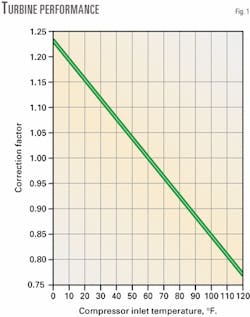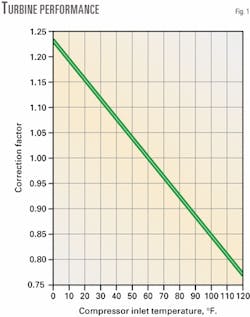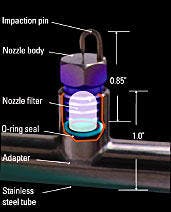El Paso Energy Corp.'s Field Services unit has successfully harnessed fog-based, evaporative cooling to gather as much as 18% more gas for its Chaco cryogenic processing plant in New Mexico.
The volume has grown to about 2.2 bcfd today from 1.8 bcfd in 1997, much of it from the San Juan gathering system in Northwest New Mexico. After processing, the gas moves to the El Paso gas pipeline system to be shipped to western states and northern Mexico.
Central to this rise in production has been the output of the Chaco plant, in Bloomington, NM, 20 miles south of Farmington.
This article discusses the changing market forces that caused adoption of fog, how El Paso Energy harnesses the technology, and the results obtained.
Market forces
El Paso Energy has been able to take advantage of the shifts in supply and demand as a result of industry deregulation across America.
The increased need for natural gas-fired power generation in the US-driven primarily by stricter emission standards and new higher-efficiency gas-turbine technology-has resulted in increased demand for natural gas in many regions of the country.
With North American gas flow trends favoring movement of Canadian gas supplies to midwestern and eastern markets, El Paso Natural Gas Co. has been transporting increasing gas volumes from southwestern US producing basins into California.
The San Juan basin, in particular, has been heavily involved in the dramatic surge in gas volume to California. El Paso Corp. runs a 5,000-mile gathering system in the basin for about 1.2 bcfd of conventional natural gas supplies.
This system delivers to El Paso Field Services' Chaco and Conoco Inc.'s Blanco processing plants for redelivery to El Paso Natural Gas. The San Juan gathering system connects 9,400 wells, owned primarily by Burlington Resources Inc., Amoco Production Co., and Conoco.
To keep up with growing demand, El Paso Energy opened the Chaco cryogenic processing plant in 1996. The processing facility contains three refrigeration/de-ethanizer compressors and has a processing capacity of more than 500 MMcfd with NGL production of 50,000 b/d. It recovers 100% of propane and heavier components and 93% of the ethane from the gas stream.
Increasing production
In 1998, El Paso Field Services executed a compression project to reduce field delivery pressures and increase production by an estimated 130 MMcfd. This $50-million project included installation of about 36,000 hp of new field compression and construction of an additional 56 miles of pipeline.
Ten new compressor units were added at five locations on its 5,500-mile system. These additional units lowered average wellhead pressures to about 150 psig on 70% of its high-pressure gathering system, affecting approximately 3,000 wells.
Most of this increased volume went straight to the Chaco plant.
Even with this surge in capacity, however, El Paso Field Services still had a major problem. While Chaco had averaged gathering 472 MMcfd over the course of one operating quarter, this number dropped dramatically during the summer.
According to the plant staff, less than 400 MMcfd would move when the temperature soared. This situation severely curtailed the plant's output.
Chaco engineers discovered that during hot weather, the combustion turbines (CT) produce up to 20% less power than in winter (Fig. 1). This is because the power output of a turbine depends on the flow of mass through it. On hot days, when air is less dense, power output falls off.
Since the pumps that pushed the gas into Chaco were powered by gas turbines, the facility was not receiving the volume needed to satisfy demand.
In response, El Paso augmented the power of two of its GE Frame 5 CTs by installing a high-pressure fog system manufactured by Mee Industries, Monrovia, Calif. Fog systems use high-pressure water pumps to pressurize reverse osmosis (RO) water that flows through a network of stainless steel tubes to fog nozzle manifolds that are installed in the air stream inside the inlet duct.
These nozzles atomize the water into micro-fine fog droplets that evaporate quickly and cool the air. Feeding cooler air into the CT increases mass flow, resulting in higher output. At Chaco, that translates to an extra 72 MMcfd, depending on ambient conditions.
Savings were about $10,000/day, assuming a daily average increase in pumped gas at 9%. (On hot days this could rise to 16-18%.)
Of the previously mentioned hot-day rate of 400 MMcfd, 9% comes to 36 MMcfd. At $300/MMcfd, this increases revenue at the Chaco plant by $10,800/day.
In comparison, the cost of operating the fog system works out at $603/day for 24 hr continuous operation: 720 gal of RO water at $0.05/gal = $360/day; power to fog skid = $75/day; maintenance cost estimate of $2/hr = $48/day; amortization of capital at $3/hr = $72/day.
The climate of New Mexico, however, makes fogging at the cryogenic plant a seasonal activity. Between October and April, the system usually isn't needed because temperatures remain low. In the other 5 months of the year, Chaco runs the fog system at maximum capacity to ensure turbine power output remains high.
Almost all of the US, in fact, can harness fog for power augmentation. Natural gas producers in Canada and Alaska may only gain 4 months' use out of the system, whereas those in California, Texas, and Florida can use it for much of the year (see sidebar).
Fog system components
The fog system at the Chaco plant consists of a series of four high-pressure (2,000 psi) skid-mounted pumps (one 3 hp, three 5 hp), an Allen Bradley PLC control system, and an array of fog nozzle manifolds.
Each pump is connected to a fixed number of fog nozzles, representing one discrete stage of fog cooling. (There are seven stages in total.) The pumps are turned on sequentially to control the amount of cooling. With seven stages, a 21° F. drop in temperature is managed in 3° F. increments.
The fog system is monitored via a built-in PLC. This regulates the flow and pressure of water to ensure proper function of the skid components.
Weather sensors are connected to the PLC to monitor ambient temperature and humidity. Proprietary control software by Mee Industries automatically turns on or off each of seven stages of fog cooling, depending on the capacity of the inlet air to absorb water vapor.
The nozzle manifolds and the fog nozzles are made of stainless steel. The impaction pin nozzles make droplets small enough to create a fog (Fig. 2).
Each Chaco plant turbine has 224 nozzles. These nozzles have orifice diameters of 0.006 in. and produce 10-µm fog droplets, which are ideal for inlet air cooling and small enough to reduce the possibility of compressor damage that could be caused by bigger water droplets.
With the mean droplet size kept around 10 µm, cooling efficiency is high and water use minimal. At Chaco, this provides as much as 35° F. of cooling.
The plant uses a fogging technique known as intercooling or overspray. By purposefully injecting more fog into the inlet air stream than can be evaporated, turbine operators produce larger power boosts than would normally be associated with ambient conditions.
How does it work? First, enough high-pressure fog is injected to exceed 100% relative humidity. Unevaporated fog droplets are then carried by the air stream into the first stages of the turbine compressor section, where compression has heated the air.
Higher temperatures increase the moisture-holding capacity of air, so that the fog droplets that would not evaporate in the inlet air duct do so in the compressor.
Once the fog evaporates in the compressor, it cools and makes the air more dense. This results in a reduction of compressor outlet temperature and increases turbine efficiency. This increases fuel flow, thus generating more power.
When applied at Chaco, this additional surge of power was accomplished with no problems with blade coating or compressor fouling. In fact, the compressor blades were found to be far cleaner than before.
Environmental bonus
While not the reason for the initial installation, Chaco's fog system has also resulted in a reduction in emissions. By increasing the power output of the turbine, some people would expect the level of NOx emissions to increase correspondingly; however, the opposite is true.
Gas turbine NOx comes from the oxidization of atmospheric nitrogen (i.e., it is not a product of fuel; it comes from the air). NOx formation is a strong function of combustion temperature. The presence of water vapor in the combustion air reduces hotspots, which are the primary source of NOx. Thus, it is the quenching effect of fog that makes the difference.
The result is increased power and lower NOx emissions.
The author
Drew Robb is a Los Angeles-based writer specializing in engineering and technology. He majored in Geology at the University of Strathclyde in Scotland in 1978. Since then he has pursued a writing career in both the UK and the US. He is president of Robb Editorial.
Determining cooling potential
Determining how much cooling can be produced by evaporation at a given location at a given time requires two temperature readings:
- Dry bulb temperature-The ambient temperature as recorded by an ordinary thermometer.
- Wet bulb temperature-The temperature recorded with a thermometer whose sensing bulb is covered with a wet wick.
The difference between the two readings, the "wet bulb depression," shows how much the air temperature can be lowered through evaporative cooling.
With a dry bulb temperature of 80° F. and a wet bulb reading of 60° F., the wet bulb depression is 20° F. Taking these readings every hour for a year yields the number of evaporative cooling-degree-hours (ECDH) that can be achieved in a specific climate. For example, if the wet bulb depression is 10° F. for 8 hr, rising to 25° F. for 4 hr, you have 180 cooling-degree-hours for that day.
Based on 30-year averages of US Department of Energy (DOE) daily and hourly temperature measurements, researchers at Mee Industries calculated the number of monthly and annual cooling-degree-hours (CDH) across the country. (A minimum wet bulb temperature of 50° F. was used as a cutoff point to prevent the possibility of inlet icing.)
By calculating the CDH for your plant location, you can estimate the amount of generating capacity being lost every year. As a rule of thumb for most gas turbines, each degree of increase in air temperature results in an output power loss of about 0.4% with a similar gain when inlet cooling is applied.
Multiplying the generating capacity of the power plant by the number of ECDH/year and then taking 0.4% of that figure will yield the amount of additional energy that can be obtained through inlet fogging.
In New Mexico, there is 0 CDH available from October through April. In the other 5 months, however, there are 40,704 CDH, and in the critical months of July and August the CDH is more than 11,000 each month.
The figure shows the cooling potential for each region of the Lower 48.



